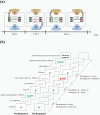Smaller Than Expected
- PMID: 34374306
- PMCID: PMC8691205
- DOI: 10.1027/1618-3169/a000516
Smaller Than Expected
Erratum in
-
Correction to Giesen et al., 2021.Exp Psychol. 2021 Sep;68(5):284. doi: 10.1027/1618-3169/a000532. Epub 2021 Nov 9. Exp Psychol. 2021. PMID: 34751038 No abstract available.
Abstract
In two pre-registered studies, we investigated whether processes of imitative action regulation are facilitated after experiencing an episode of social exclusion. We reasoned that imitative action regulation effects should be more pronounced for participants who were socially excluded, providing them with an "automatic means" to socially reconnect with others. Participants played a virtual ball-tossing game to experimentally induce social exclusion or inclusion experiences. Subsequently, pairs of two participants engaged in an observational stimulus-response (SR) binding paradigm modeled after Giesen et al. (2014): Participants observed color categorization responses in their interaction partner (trialn-1) and then executed (in)compatible responses in the subsequent trial (trialn), with observation and responding occurring in alternation. Stimulus relation (repetition vs. change) from trialn-1 to trialn was orthogonally manipulated. In both studies, stimulus-based retrieval effects of observationally acquired SR bindings were descriptively larger in socially excluded (compared with socially included) participants. However, none of the effects were statistically significant. Even a joint analysis of both experiments did not show the expected modulation. We discuss the implications of our findings for research on social exclusion effects on imitative action regulation processes.
Keywords: action imitation; event files; observational learning; social exclusion; stimulus–response binding.
Figures

Similar articles
-
Intimacy Effects on Action Regulation: Retrieval of Observationally Acquired Stimulus-Response Bindings in Romantically Involved Interaction Partners Versus Strangers.Front Psychol. 2018 Aug 3;9:1369. doi: 10.3389/fpsyg.2018.01369. eCollection 2018. Front Psychol. 2018. PMID: 30123169 Free PMC article.
-
Not so social after all: Video-based acquisition of observational stimulus-response bindings.Acta Psychol (Amst). 2021 Jun;217:103330. doi: 10.1016/j.actpsy.2021.103330. Epub 2021 May 12. Acta Psychol (Amst). 2021. PMID: 33991796
-
Retrieval effects of observationally acquired stimulus-response bindings in participants with high and low autistic traits.J Exp Psychol Hum Percept Perform. 2022 Mar;48(3):191-201. doi: 10.1037/xhp0000980. Epub 2022 Feb 7. J Exp Psychol Hum Percept Perform. 2022. PMID: 35130016
-
Automatic imitation.Psychol Bull. 2011 May;137(3):463-83. doi: 10.1037/a0022288. Psychol Bull. 2011. PMID: 21280938 Review.
-
Imitation and local enhancement: detrimental effects of consensus definitions on analyses of social learning in animals.Behav Processes. 2013 Nov;100:123-30. doi: 10.1016/j.beproc.2013.07.026. Epub 2013 Aug 14. Behav Processes. 2013. PMID: 23954830 Review.
Cited by
-
Reluctance against the machine: Retrieval of observational stimulus-response episodes in online settings emerges when interacting with a human, but not with a computer partner.Psychon Bull Rev. 2022 Jun;29(3):855-865. doi: 10.3758/s13423-022-02058-4. Epub 2022 Jan 21. Psychon Bull Rev. 2022. PMID: 35064526 Free PMC article.
References
-
- Blackhart, G. C., Nelson, B. C., Knowles, M. L., & Baumeister, R. F. (2009). Rejection elicits emotional reactions but neither causes immediate distress nor lowers self-esteem: A meta-analytic review of 192 studies on social exclusion. Personality and Social Psychology Review, 13(4), 269–309. 10.1177/1088868309346065 - DOI - PubMed
LinkOut - more resources
Full Text Sources
Research Materials

